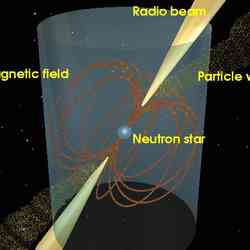

The current understanding of a pulsar. Image credit: Jodrell Bank Observatory. Click to enlarge
Astronomers have discovered a very unusual pulsar that seems to switch off from time to time. It looks like a normal pulsar for about a week, blasting out radio waves, and then goes silent for about a month. This pulsar is slowing down its rate of rotation, but this deceleration increases when it’s active. This braking mechanism is related to the powerful radio emissions. During its active phase, a wind of particles is spewed off, stealing some of its rotational energy.
Astronomers using the 76-m Lovell radio telescope at the University of Manchester’s Jodrell Bank Observatory have discovered a very strange pulsar that helps explain how pulsars act as ‘cosmic clocks’ and confirms theories put forward 37 years ago to explain the way in which pulsars emit their regular beams of radio waves – considered to be one of the hardest problems in astrophysics. Their research, now published in Science Express, reveals a pulsar that is only ‘on’ for part of the time. The strange pulsar is spinning about its own axis and slows down 50% faster when it is ‘on’ compared to when it is ‘off’.
Pulsars are dense, highly magnetized neutron stars that are born in a violent explosion marking the death of massive stars. They act like cosmic lighthouses as they project a rotating beam of radio waves across the galaxy. Dr Michael Kramer explains, “Pulsars are a physicist’s dream come true. They are made of the most extreme matter that we know of in the Universe, and their highly stable rotation makes them super-precise cosmic clocks – but, embarrassingly, we do not know how these clocks work. This discovery goes a long way towards solving this problem.”
The current understanding of a pulsar. The central neutron star is highly magnetised and emits a radio beam along its magnetic axis, which is inclined to the rotation axis. The strong magnetic field eventually leads to the extraction of particles from the surface, filling the surrounding, so-called magnetosphere with plasma. The size of the magnetosphere is given by the distance where plasma co-rotation reaches the speed of light, the so-called light-cylinder. The plasma creating the radio emission eventually leaves the light cylinder as a pulsar wind, which provides a torque onto the pulsar, contributing about 50% to its observed slow-down in rotation.
The research team, led by Dr Kramer, found a pulsar that is only periodically active. It appears as a normal pulsar for about a week and then “switches off” for about one month before emitting pulses again. The pulsar, called PSR B1931+24, is unique in this behaviour and affords astronomers an opportunity to compare its quiet and active phases. As it is quiet the majority of the time, it is difficult to detect, suggesting that there may be many other similar objects that have, so far, escaped detection.
Prof Andrew Lyne points out that, “After the discovery of pulsars, theoreticians proposed that strong electric fields rip particles out of the neutron star surface into a surrounding magnetised cloud of plasma called the magnetosphere – but, for nearly 40 years, there had been no way to test whether our basic understanding was correct.”
The University of Manchester astronomers were delighted when they found that this pulsar slows down more rapidly when the pulsar is on than when it is off. Dr Christine Jordan points out the importance of this discovery, “We can clearly see that something hits the brakes when the pulsar is on.”
This breaking mechanism must be related to the radio emission and the processes creating it and the additional slow-down can be explained by a wind of particles leaving the pulsar’s magnetosphere and carrying away rotational energy. “Such a braking effect of the pulsar wind was expected but now, finally, we have observational evidence for it” adds Dr Duncan Lorimer.
The amount of braking can be related to the number of charges leaving the pulsar magnetosphere. Dr Kramer explains their surprise when it was found that the resulting number was within 2% of the theoretical predictions. “We were really shocked when we saw these numbers on our screens. Given the pulsar’s complexity, we never really expected the magnetospheric theory to work so well.”
Prof Lyne summarized the result: “It is amazing that, after almost 40 years, we have not only found a new, unusual, pulsar phenomenon but also a very unexpected way to confirm some fundamental theories about the nature of pulsars.”
Original Source: PPARC News Release
Astronomers have developed several versions of rotating liquid metal telescopes, which use the force of…
One planet was missing from the sunset lineup… until now. Perhaps you’ve seen the news…
The giant-impact hypothesis posits that billions of years ago a Mars-sized body named Theia collided…
What can Venus atmospheric samples returned to Earth teach us about the varied evolution of…
Type 1a supernovae are extremely powerful events that occur in binary systems containing at least…
What's the story of our Moon's early history? Despite all we know about our closest…